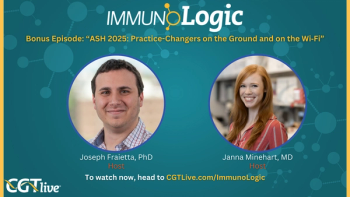
Brexu-Cel Shows Efficacy in Mantle Cell Lymphoma in Real-World Setting
High response rates were seen in patients that would not meet ZUMA-2 eligibility criteria.
Brexucabtagene autoleucel (brexu-cel, Tecartus; Kite), a chimeric antigen receptor (CAR) T-cell therapy, has shown favorable efficacy and safety for the treatment of relapsed/refractory (R/R) mantle cell lymphoma (MCL) in clinical practice, according to results from a real-world experience study.
These real-world findings were presented at the
"Brexu-cel is an FDA approved therapy for R/R MCL, based on results from ZUMA-2 study. We report the safety and efficacy of BA in standard of care practice among centers in the US Lymphoma CAR-T Consortium,” Jain and colleagues wrote.
This retrospective study collected data from 16 centers part of the CAR T Consortium and included 189 patients who underwent leukapheresis by 12/31/2021 with an intent to manufacture brexu-cel. Investigators collected data including baseline clinical characteristics, bridging therapy, adverse events (AEs) after infusion, and outcome data. These data were used retrospectively to determine ZUMA-2 eligibility (NCT02601313).
WATCH NOW:
Of patients that underwent leukapharesis, 167 (88%) were infused with brexu-cel and 22 (12%) were not. Patients had a median age of 67 years and patient characteristics included high risk simplified Mantle Cell International Prognostic Index (MIPI) scores (16%), at least 50% Ki-67 index (57%), aggressive histology (41%), TP53 alteration (49%), progression of disease within 24 months (POD24; 51%), and central nervous system (CNS) involvement (10%).
Patients had a median of 3 prior lines of therapy (range, 1-10) and most patients (86%) had received prior BTK inhibitor (BTKi) treatment and had refractory disease to this treatment (89%). Most patients (n = 113; 68%) received bridging therapy including BTKi, venetoclax, and chemotherapy. The median time from leukapheresis to lymphodepletion chemotherapy was 28 days (range, 17-140). ZUMA-2 eligibility criteria would have excluded most patients (n = 130; 78%).
Almost all patients (90%) across centers experienced cytokine release syndrome (CRS) but only 8% of cases were at least grade 3, although 1 case was grade 5. Similarly, the rate of immune effector cell-associated neurotoxicity syndrome (ICANS) was 61% with 32% of cases at grade 3 or higher. These AEs were managed with tocilizumab (n = 125; 76%), corticosteroids (n = 112; 68%), and anakinra (n = 27; 16%). Some patients required ICU admission (n = 32; 20%), vasopressors (n = 18; 11%), and/or mechanical ventilation (n = 5; 3%).
Jain and colleagues analyzed survival outcomes with the Kaplan-Meier method and found that overall response rate (ORR) was 89% and complete response (CR) rate was 70% at day 30, when 155 patients were evaluable. The best ORR was 89%, with an 80% CR rate and 9% partial response (PR) rate.
By subgroup, patients with aggressive histology had an 88% ORR and 79% CR rate; patients with high Ki-67 had an 89% ORR and 77% CR rate; patients with altered TP53 had a 90% ORR and 72% CR rate; patients with CNS involvement had an 81% ORR and 75% CR rate; patients with prior BTKi treatment had an 89% ORR and 79% CR rate; patients that were BTKi-naïve had a 91% ORR and 83% CR rate; and patients that did not meet ZUMA-2 eligibility criteria had an 89% ORR and 78% CR rate.
Median duration of response (DOR) was not reached; DOR at 6 months was 67% (95% CI, 57-75). Median follow-up was 5.6 months (range, 0.2-15.3), median progression-free (PFS) survival was not reached, and PFS at 6 months was 63% (95% CI, 54-71). Median overall survival (OS) was 15.3 months and OS at 6 months was 85% (95% CI, 77-90).
“This multicenter retrospective study demonstrated encouraging safety and efficacy data of BA in R/R MCL in the real-world practice. Despite 78% of the pts being ineligible for ZUMA-2, the responses, CRS, ICANS and outcomes were comparable to ZUMA-2 data. Long term safety and efficacy will be reported,” Jain and colleagues concluded.
To read more coverage of ASCO 2022,
REFERENCE
Jain P, Wang Y, Locke FL, et al. Brexucabtageneautoleucel for relapsed/refractory mantle cell lymphoma: Real-world experience from the United States lymphoma CAR T consortium. Presented at: 2022 ASCO Meeting, June 3-7; Chicago, IL. Abstract # e19583
Newsletter
Stay at the forefront of cutting-edge science with CGT—your direct line to expert insights, breakthrough data, and real-time coverage of the latest advancements in cell and gene therapy.





































